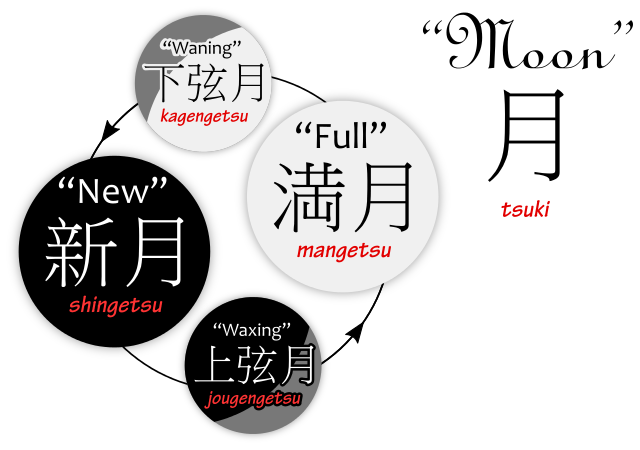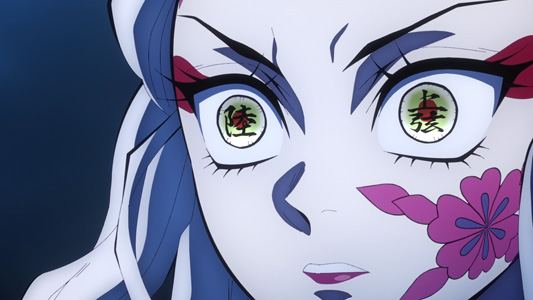The terms for the "moon phases" in Japanese, gessou 月相, would be:
| English | Romaji | Kanji |
|---|---|---|
| New Moon | shingetsu | 親月 |
| Waxing crescent Moon | jougengetsu | 上弦月 |
| Full Moon | mangetsu | 満月 |
| Waning crescent Moon | kagentsu | 下弦月 |
The word for "Moon" in Japanese is tsuki 月, e.g. tsuki ga kirei 月がきれい, "the Moon is pretty." This word is the kun'yomi 訓読み of the kanji, getsu is the on'yomi 音読み.
Vocabulary
The waxing and waning moons are also abbreviated jougen 上弦 and kagen 下弦.
Anime: Demon Slayer: Entertainment District Arc, Kimetsu no Yaiba: Yuukaku-hen 鬼滅の刃 遊郭編 (Episode 8)
- Context: in Kimetsu no Yaiba, there are twelve oni 鬼, "demons," called the Juuni Kidzuki 十二鬼月, "Twelve Demon Moons," which are divided into upper and lower ranks, or, more literally, "waxing," jougen 上弦, and "waning," kagen 下弦, ranks..
- Daki is the upper sixth, jougen no roku 上弦の陸, literally "the sixth of the waxing [ones] (the upper ones)." The kanji for jougen and roku are literally inscribed in her eyes.
- roku 陸, the number "six," is normally spelled 六. The more complicated 陸 is called a daiji 大字, literally "large character," and is used when numbering things formally or more ceremonially.
- By the way, in the series the lower first demon Enmu 魘夢 has ichi 一, "one," inscribed in the right eye, and shita-ichi 下壱, "lower one," inscribed in the other eye, as opposed to having kagen inscribed.
The word gengetsu 弦月 can refer to either waning or waxing Moons. They're also called "half Moon," hangetsu 半月.
The morphemes jou 上 and ka 下 mean the directions "up" and "down," respectively. A jougengetsu 上弦月 is a half-Moon that is going up, increasing, while a kagengetsu 下弦月 is one that is going down, decreasing.
The shin 新 in shingetsu 新月 means "new," like in the i-adjective atarashii 新しい, "new."
The man 満 in mangetsu 満月 means "full," and is found in words like "full tank," mantan 満タン, "satisfied," manzoku 満足, and so on.


Hope to read about calendar, why they don't use the Japanese word for it (if it exists) nice info
ReplyDelete